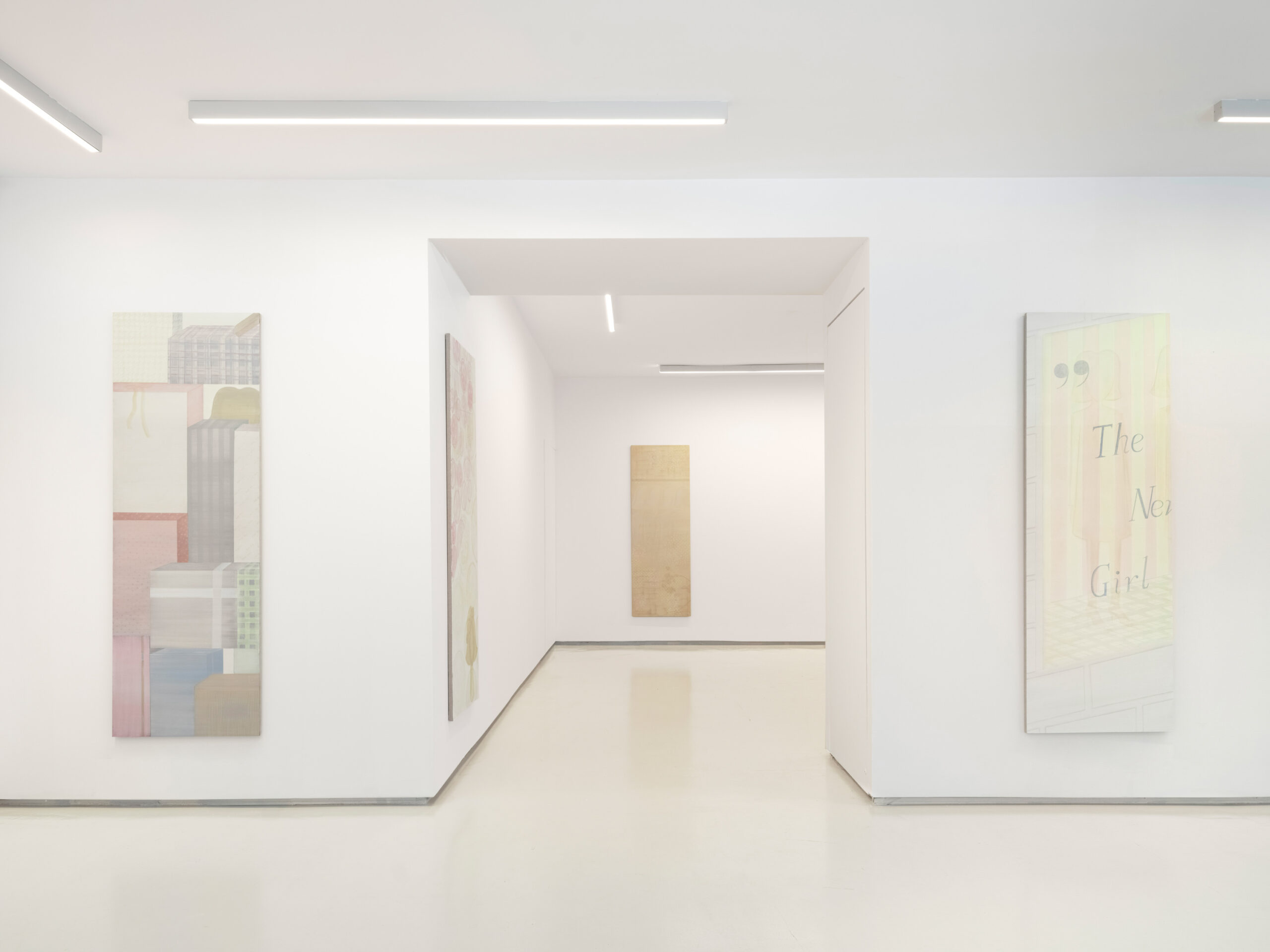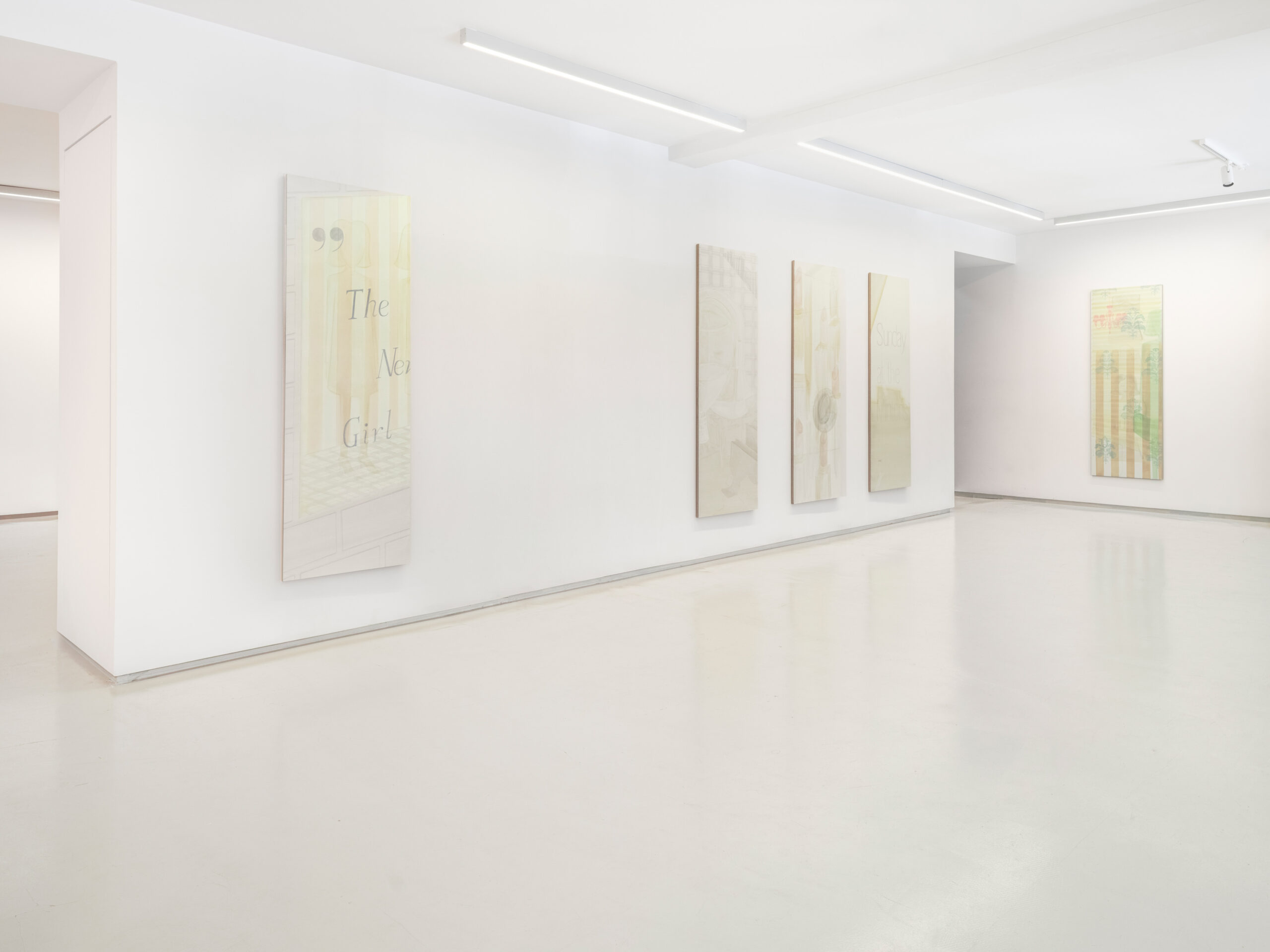Weronika Guenther
Prada Blue
June 12 – August 1, 2025
The girlhood archetypes embodied in Weronika Guenther’s work evoke the literary genre of roman à clef, as discussed by Lauren Fournier. Fournier describes this form as particularly resonant with autotheory, due to its blending of factual elements with fictionalised characters and events. The act of uncovering the authenticity of these connections becomes central to interpretation, serving as a key to decoding the autofictional layers within the narrative. It is difficult to pinpoint the source of Guenther’s metropolitan panoramas – whether they stem from the Warsaw skyline visible from her studio, or from a cinematic vision of Manhattan. These images, often approaching geometric abstraction, are superimposed with text fragments, newspaper headlines, and product rows – forming a visual field clouded by a consumerist, hallucinatory afterimage.
Guenther filters cinematic and literary narratives of mademoiselle culture in the big city through the lens of specific situations and her own lived experiences. The heroines of her paintings – or rather, their shadows – evoke iconic It Girls from the silver screen: Blair Waldorf from Gossip Girl, Andy Sachs from The Devil Wears Prada, Rebecca Bloomwood from Confessions of a Shopaholic, and even Keira Knightley in the Chanel Coco Mademoiselle perfume advert. Guenther sets the portrayed figures into grids of office windows or captures their reflections in shopfronts, confining them within rectangular structures, as though composing a photograph. Her mental lens is focused on signboards and goods in display cases. The resulting image resembles a photograph, with faint silhouettes appearing in the background. The proportions of the canvases echo the dimensions of shop windows. The paint, applied in smooth, translucent glazes, alludes to the visual language of advertising. Object and image function in tandem, forming a coherent and integrated whole.
In some cases, it is unclear who plays the leading role – Guenther fuses the stage sets with the actresses who inhabit them. She overlays the scenes with monograms, fabric patterns, and barely legible diary entries. Yet these additions feel inconsequential, like faded annotations from invented memoirs. At times, characters from Guenther’s paintings reappear in spatial installations – for instance, positioned within a labyrinth constructed from boxes of designer accessories. This recalls a 1991 advertisement featuring Vanessa Paradis, in which the French singer and actress plays a bird trapped in a gilded cage. Guenther strikes a similar tone, evoking the entanglement of desire and entrapment that lies at the heart of consumer culture.
Guenther’s use of romantic phantasms and their pop-cultural renderings also evokes associations with Chantal Akerman’s Golden Eighties. In 1986, the Belgian director filmed a musical set in an underground shopping arcade. The venue becomes a space where the characters work and play, sing and dance – and above all, gossip and flirt. Her protagonists confront their feelings, often struggling to confess them while separated by the velour curtain of a changing room. Walter Benjamin once observed: “Every fashion is to some extent a bitter satire on love; all sexual perversities are suggested in every fashion by the most ruthless means; every fashion is filled with secret resistances to love.” It is no coincidence that Akerman set her film in such a context – by emphasising musical spectacle over narrative, the film explores the artificiality of projections of normative, heterosexual love. It speaks to the longings, fantasies, hopes, and fears that surround such love – along with its inevitable disappointments.
The very title of the exhibition was inspired by the colour of Prada’s archival shoe boxes – highly coveted by true fashionistas. At the same time, it can be read as a defiant nod to the male-centric canon of contemporary art, specifically as a playful paraphrase of Yves Klein Blue. In this context, the installations composed of boxes from Chanel, Christian Louboutin, Miu Miu, and Saint Laurent may be interpreted as tongue-in-cheek references to Donald Judd’s objects; the stripes in the paintings, as visual quotations of Daniel Buren’s work; and the simplified architectural elements with inscriptions, as variations on Ed Ruscha’s oeuvre.
When we look at Guenther’s work from this angle, we touch upon the intersection of fashion and the visual arts, as well as the market forces that shape both fields. As Charlie Porter argues, the connection between fashion and art is frequently shaped by commercial interests: “Most of the time, when we talk about the relationship between fashion and art, what we’re really talking about is two industries coming together in search of profit. This manifests most often in collaborations between artists and designers, hook-ups with a veil of creativity that are actually about selling product. It’s fuelled by the perception that art is a commodity, a luxury good.” Weronika Guenther appears to engage with these issues without feeling compelled to subject them to overt critique. Instead, she acknowledges their presence and treats the aesthetics of her own practice and those of the prêt-à-porter industry as equally valid. Her works offer a broader commentary on the realities of the market. Her opinions are not intended to criticise the state of affairs. Rather, they reflect acceptance and curiosity, marking an attempt to analyse the essence of consumerist desire, the passion behind them, and the loneliness that this craving conceals.
Text by Franciszek Smoręda



